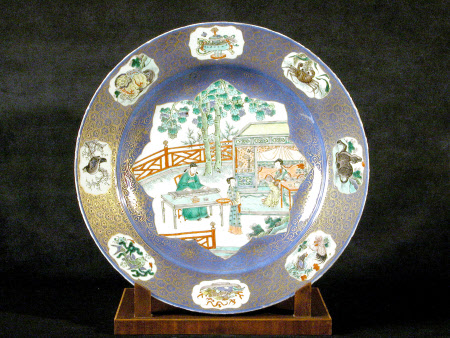Dish
Category
Ceramics
Date
1700 - 1720
Materials
Porcelain, cobalt, enamel, gold.
Measurements
58 mm (Height); 397 mm (Diameter)
Place of origin
Jingdezhen
Order this imageCollection
Saltram, Devon
NT 870942
Summary
Dish, porcelain, round with a flat rim, made in Jingdezhen, Jiangxi Province, China, Kangxi period (1662–1722), 1700–20, covered in underglaze powder blue decorated in gold with a pattern with hexagonal cells and with stylised peony flowers and foliage, with reserved areas decorated in the famille verte (‘green family’) palette in overglaze enamels, a lobed and pointed area in the centre with a narrative scene representing a terrace with a man seated at a table playing a guqin 古琴 or zither, a woman seated on the edge of a canopy bed listening to the music and a servant bringing tea, with a pair of wutong 梧桐 or Chinese parasol trees behind, and with eight reserved lobed and pointed panels along the rim with vignettes of animals and auspicious objects.
Full description
This dish was catalogued as no. 253T in Neatby (ed.) 1977. The central image appears to be a scene from a novel or play, possibly the drama Xixiangji 西廂記 or Romance of the Western Chamber by Wang Shifu 王實甫 (c. 1250–1337). Wutong trees were considered particularly auspicious, as benevolent phoenixes were thought to alight on them. As the wood of the wutong (Firmiana simplex) is particularly resonant, it is used to make musical instruments like the guqin, so the presence of both in this image may well be a deliberate echo. The word wutong is reminiscent of the word tong 同, meaning ‘in common’, which, combined with the fact that there are two trees growing close together, may hint at the emotional connection between the two main protagonists in the scene. The use of an underglaze cobalt blue ground is sometimes called Mazarin (or Mazareen) blue in English, after the French bleu Mazarin, possibly after Cardinal Mazarin (1602–61), prime minister of France, or his niece Hortense Mancini, Duchesse de Mazarin (1646–99) – but the reason for this is obscure. The cobalt could be applied through blowing (as in this case), painting or dipping and was decorated in painted gold. Areas of the porcelain could be covered with paper shapes while the cobalt was applied, resulting in white reserves which could then be decorated with famille verte enamels, further enhancing the appearance and desirability of the porcelain (Ferguson 2016). Almost identical dishes are in the Rijksmuseum, Amsterdam, inv. no. AK-RBK-15844-A (Jörg 1997, where it is suggested that the famille verte decoration on this specific type of dish may have been added later); and in the Philadelphia Museum of Art, inv. no. 1955-50-60. A pair of almost identical dishes was sold at Christie’s Amsterdam on 3 October 2012, lot 402. For a pair of similar dishes with a slightly different romantic subject, see Vinhaís and Welsh (eds.) 2023.
Provenance
Accepted by HM Government in lieu of inheritance tax and allocated to the National Trust, 1957.
References
Ferguson 2016: Patricia F. Ferguson, Ceramics: 400 Years of British Collecting in 100 Masterpieces, Philip Wilson Publishers, 2016, pp. 60-1 Neatby (ed.) 1977: Nigel Neatby (ed.), The Saltram Collection, London, 1977., p. 64 Jörg 1997: Christiaan Jörg, Chinese Ceramics in the Collection of the Rijksmuseum, Amsterdam: The Ming and Qing Dynasties, London, 1997, cat. 159., p.146 Vinhaís and Welsh (eds.) 2023: Luísa Vinhais and George Welsh (eds.), Noble Blue: The Enduring Appeal of Blue Ground Chinese Porcelain, London, 2023, cat. 26., pp. 166-9
